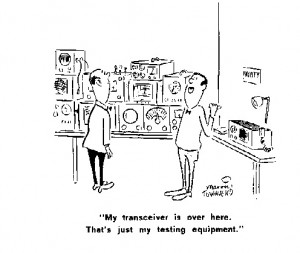The Basics: Every amateur radio station should be provided with the following minimal test equipment: A frequency-measuring instrument accurate to within 10 Hz. An RF power meter capable of measuring forward and reflected power, or power and VSWR. An accurate digital multimeter (with a high-voltage probe for safe measurement of voltages above 500V). Assorted RF jumper cables (PL-259, BNC, N, SMA in various combinations.) A well-regulated bench power supply (13.8V/25A minimum).
For the advanced Ham: For more sophisticated station adjustment (SSB audio, modulation envelope, tones in digital modes etc.), we should add: An oscilloscope with a minimum 3 dB bandwidth of 50 – 100 MHz. An audio signal generator (or tone-generator software) covering 50 Hz – 100 kHz. A good-quality frequency counter with a minimum frequency range of 100 MHz, preferably with a 1 GHz C-channel. A handheld antenna analyser. A grid-dip oscillator.
Now we’re getting serious: Radio amateurs who are interested in aligning and repairing their own (or their friends’) radio gear may wish to go a few steps further: A good-quality RF signal generator covering 400 kHz to 500 MHz, with a built-in attenuator. An FM communications service monitor. An RF spectrum analyser with an upper frequency limit of at least 100 MHz (for HF) or 1 GHz (for HF/VHF/UHF and up), with a minimum resolution bandwidth of 100 Hz. A tracking generator for use with the spectrum analyser, or alternatively a vector network analyser (VNA). An RF millivoltmeter or microwattmeter (100 kHz – 1 GHz, -50 to +30 dBm). A number of good-quality fixed RF attenuators. A good RF step attenuator. A variable-voltage bench power supply (0 – 20V, 25A). A vector network analyser (free-standing or PC-based). For those interested in radio performance evaluation: We have already accumulated a pretty good little RF lab here. For radio performance testing, we can add: A second high-quality RF signal generator and a hybrid combiner, for 2-signal receiver testing. An audio 2-tone generator, or equivalent tone-generator software. An RF noise generator. A precision 10 MHz frequency standard with low phase noise, to clock other instruments using a 10 MHz reference (e.g. counters, signal generators). A pulse generator, for AGC and noise-blanker testing. Baseband spectrum-analysis software, for filter response measurements etc. An audio distortion analyser, distortion meter or SINAD meter.
Won’t I go broke buying all this kit? Requires technical information here


